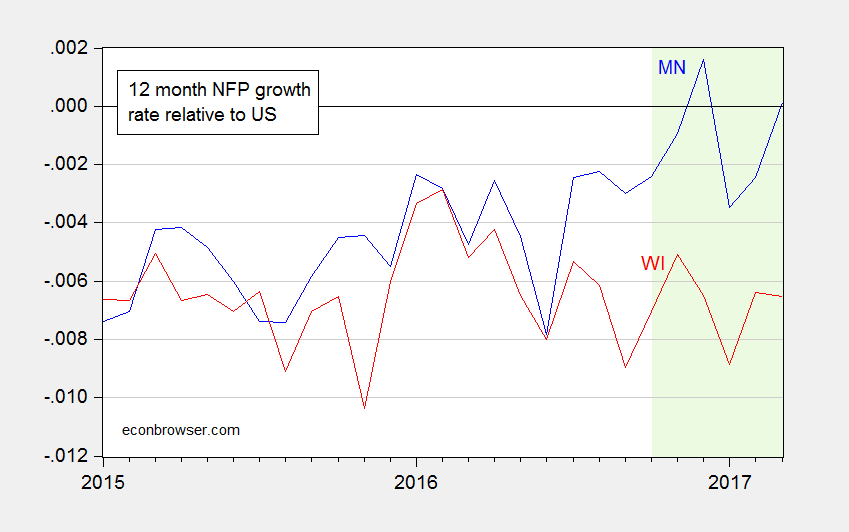A reader brings my attention to John Schmid’s article documenting the Wisconsin employment slowdown, relying on the Census of Quarterly Employment and Wages, for the year ending December 2016.
Continue reading
Category Archives: employment
Guest Contribution: “Can Google Trends Data Be Replicated?”
Today we are pleased to present a guest contribution written by Hal Varian, Emeritus Professor at the School of Information, the Haas School of Business and the Economics Department at UC Berkeley.
Beware the State Level Employment Series: Kansas Edition
Steven Kopits, in response to my caution over using state level household based employment series, writes:
If you are telling me you’re smarter than BLS, go ahead.
Well, I don’t think I’m smarter than BLS. I just think it’s a good idea to know what kind of imprecision is associated with the series one works with — so without further ado, here are two vintages of household survey based civilian employment for Kansas. Tell me what you think…
Continue reading
State Employment Trends: Some Selected States and ALEC Rankings
Since 2011 — when Scott Walker and Sam Brownback came into power — California has powered far ahead of Wisconsin and Kansas. The newly released Rich States, Poor States, 2017 allows us to look at how four states, both low and high ranked by Arthur Laffer et al., fared, employmentwise.
Minnesota Employment Growth Accelerates Relative to Wisconsin (Again)
Wisconsin and Minnesota released March employment figures today. Here, without comment (as none are needed) are year-on-year growth rates relative to the US average for Minnesota (blue) and Wisconsin (red).

Figure 1: 12 month log-differences of nonfarm payroll employment for Minnesota (blue) and Wisconsin (red), relative to US. Green shading denotes sample not updated to reflect QCEW-related benchmarking. Source: WI DWD, MN DEED, BLS, and author’s calculations.
Kansas Employment Rises to 0.3% below Previous Peak
Kansas nonfarm payroll employment rose 4,200 (0.3%) from January to February, and fell 400 (0%) relative to February 2016. In both cases the change was not statistically significant. In contrast, Missouri NFP rose 3,500 (0.1%) over the last month, and 54,000 (1.9%) over the last year.
“GOP Economist Concerned Data Quality May Be Hurt Under Trump”
That’s the title of an article in Bloomberg yesterday.
“I remain concerned, particularly in an environment where you’re talking about cutting the budget, that a victim in that exercise could be the production of good data,” Glenn Hubbard, who served as chairman of President George W. Bush’s Council of Economic Advisers from 2001 to 2003, said Monday in Washington.
December Employment in Wisconsin
Civilian employment and nonfarm payroll employment both decline.
Guest Contribution: “The Impact of Real Exchange Rate Shocks on Manufacturing Workers: An Autopsy from the MORG”
Today we are pleased to present a guest contribution written by Douglas L. Campbell (New Economic School, Moscow) and Lester Lusher (UC Davis).
“The Future’s So Bright, I Gotta Wear Shades”
That’s what Governor Walker said today about Wisconsin’s economy, quoting from a 1980’s song. This was apparently spurred by DWD’s release “Wisconsin Employment Reaches All-Time High in November”. This statement is true, when referring to the relatively imprecisely measured household survey figures [1]. It is not true when referring the (more precisely measured) establishment series.